#microfossil
Explore tagged Tumblr posts
Text

This is an acritarch from my mid Proterozoic sediments, it's usually found in association with the weird textures I've been posting. This image is a stack and stitch of 100+ images at 100x mag. It was an early attempt hence the glitches.
#geology#paleontology#FossilFriday#fossil#geologyjohnson#palaeontology#precambrian#fossils#acritarch#microfossil#proterozoic
15 notes
·
View notes
Photo

Fossil Chalk Fish Scales (Osteichthyes) | Grey Chalk Cretaceous Clyde Sussex UK | Genuine Specimen with COA
Own a rare and scientifically valuable specimen of fossil fish scales (Osteichthyes) from the Grey Chalk Formation of the Cretaceous period, collected in Clyde, Sussex, UK. These scales represent part of the bony fish group (Osteichthyes), a major vertebrate lineage that dominated Mesozoic marine environments.
Fossil Type: Fish Scales (Osteichthyes – Bony Fish)
Geological Period: Late Cretaceous (~100.5 to 89.8 million years ago)
Formation: Grey Chalk Formation
Location: Clyde, Sussex, United Kingdom
Scale Rule: Squares/Cube = 1cm (Please refer to the photo for full sizing)
Specimen: The actual specimen in the listing photo is the one you will receive
Authenticity: All of our fossils are 100% genuine specimens and come with a Certificate of Authenticity
Geological and Paleontological Context
These fossil fish scales belonged to Osteichthyes, or bony fish, a major group of marine vertebrates that thrived in the Cretaceous seas. The Grey Chalk is known for preserving delicate microfossils, vertebrate remains, and marine invertebrates from shallow, warm seas rich in calcium carbonate sediments.
Phylum: Chordata
Class: Actinopterygii (ray-finned bony fishes)
Geological Stage: Most likely Cenomanian stage (~100.5–93.9 Ma), based on regional stratigraphy of the Grey Chalk
Depositional Environment: Calm, shallow marine shelf with low-energy sedimentation; fossilisation occurred within fine calcareous sediments of the chalk sea
Morphological Features: Small, shiny or mineralised scales often showing fine ridges, growth rings, or peg-and-socket articulation patterns typical of actinopterygian fishes
Notable: Fossil fish remains in the Grey Chalk are rare compared to invertebrate fossils, making vertebrate microfossils like these valuable for collectors and paleontologists
Biozone: May be associated with the Lower to Middle Cenomanian ammonite or inoceramid zones (e.g., Mantelliceras or Inoceramus zones)
Identifier: Osteichthyan microremains have been recorded in UK chalk studies since the 19th century; formal identification to genus level often requires microscopic examination
Why This Fossil is Special
Fossil fish scales like these are a window into the vertebrate life of the Cretaceous chalk seas—often overlooked yet scientifically important. These remains can be used to reconstruct fish diversity and ecology in ancient marine ecosystems.
Why Buy From Us?
100% genuine fossil with Certificate of Authenticity
The exact item shown is the one you’ll receive
Carefully sourced from reputable UK fossil sites
Excellent for microfossil collectors, educators, and vertebrate paleontology enthusiasts
Own a piece of ancient marine vertebrate history with this Osteichthyes fossil fish scale specimen from the Grey Chalk of Clyde, Sussex—a rare glimpse into bony fish evolution from over 90 million years ago.
#fossil fish scales#Osteichthyes fossil#chalk fish fossil#Cretaceous fish fossil#Grey Chalk fossil#Clyde Sussex fossil#UK fish fossil#bony fish fossil#fossil with certificate#certified fossil#genuine fossil#prehistoric fish scale#natural history fossil#microfossil#Cretaceous marine life#vertebrate fossil
0 notes
Text
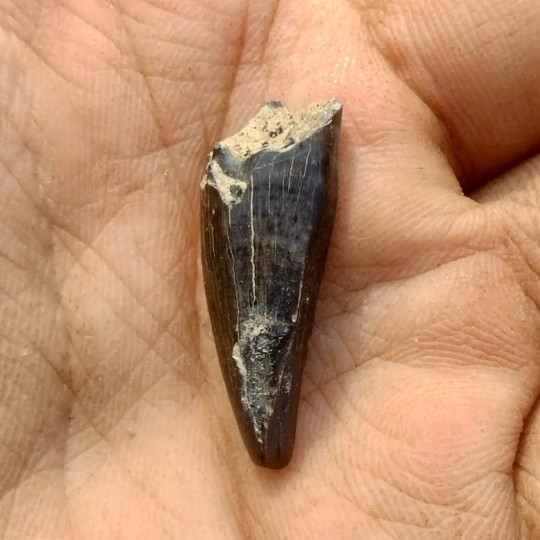
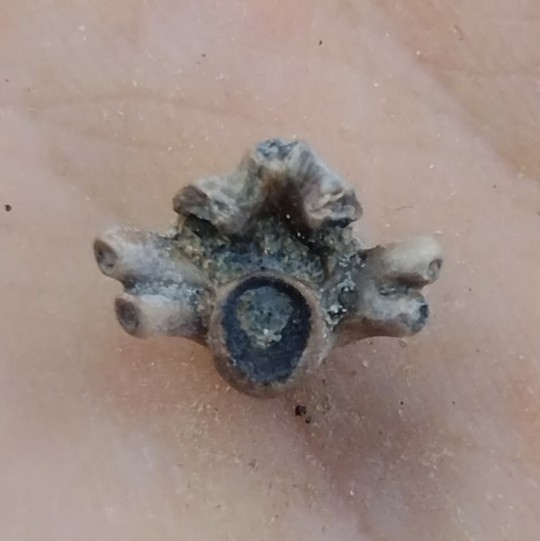
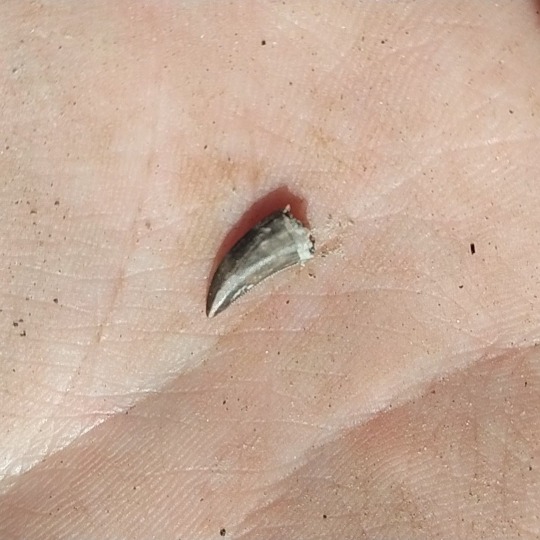
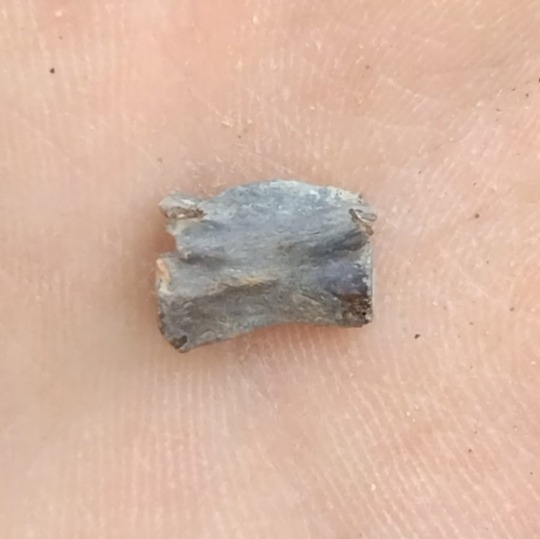

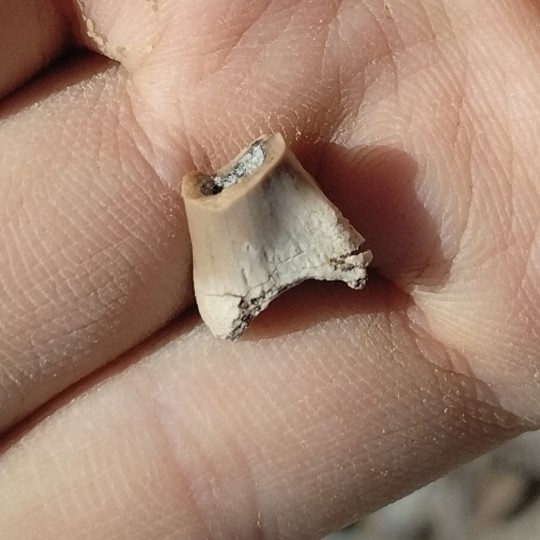



Microfossils from the Judith River Formation near Hinsdale, Montana, 2023 fieldwork season.
#microfossils#microsite#badlands dinosaur museum#paleo fieldwork#fossils#dinosaurs#tyrannosaur#theropod#paleontology#palaeontology#paleoblr#palaeoblr#fieldwork 2023#my finds
403 notes
·
View notes
Text


Drum jawbone front and back perspectives bio-illustrations from my microfossil undergrad research this semester ✨🐟
#microfossils#fossils#bio illustration#paleontology#paleoart#paleoenvironments#natural science#fossil art#fossil research#research#scientific illustration#illustration
13 notes
·
View notes
Text
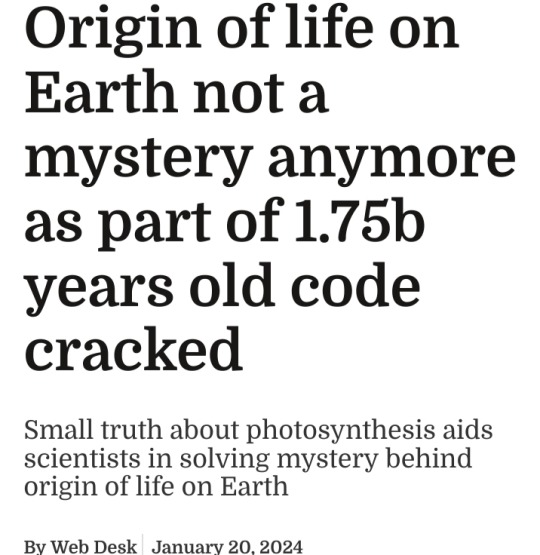
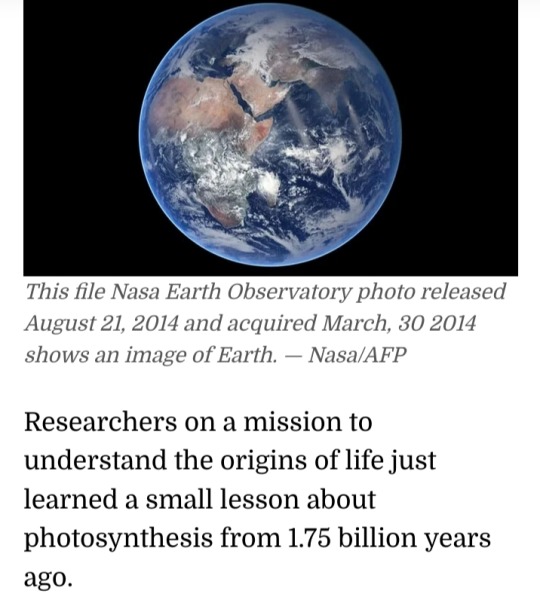

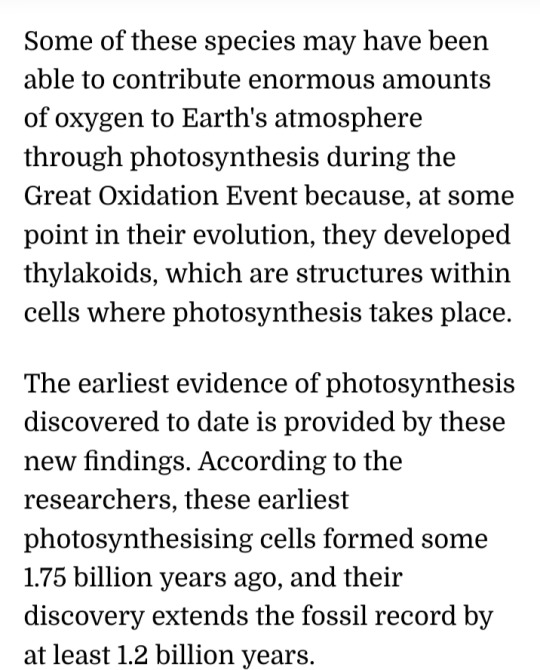
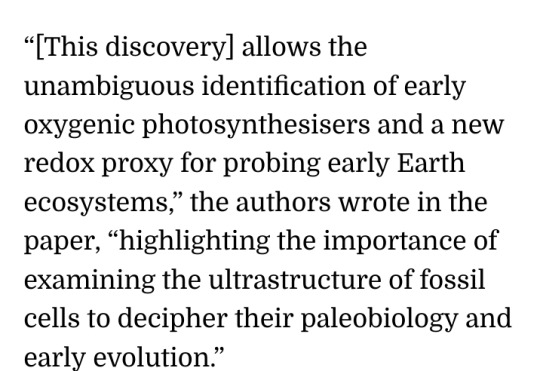

#Earth#microfossils#photosynthesis#cyanobacteria#Great Oxidation Event#thylakoids#ecosystem#origin of life#research
11 notes
·
View notes
Text
I wonder if there are more of these, I've been fascinated by these pictures from when I first saw them, like, a billion years ago.
If I could afford it, I would do so much micro-photography, maybe not as zoomed in as these, but definitely with my rock collection, because then I could get rid of a whole bunch of rocks lol.
On a random note, I helped out with a university summer science week for senior high school students during the main school holidays back home in AoNZ, with the geology department. One of the activities we did with kids was to collect a sandstone rock from the peninsula up the coast, bring it back, do the whole 'extract the fossil plankton (like, foraminifera or ostracods, etc.) from the rock and then set the kids to 'picking' the micro-fossils from the results. The kids were so happy just spending an hour or two randomly picking tiny fossils of this processed rock mix, and I remember being much the same during my geology undergrad. I mean, I was shite at the technical stuff, and identifying anything (I literally would rather dig up fossils and prep them, than figuring out all the science around them lol), because hyper-fixating, but it was fascinating and somewhat relaxing!
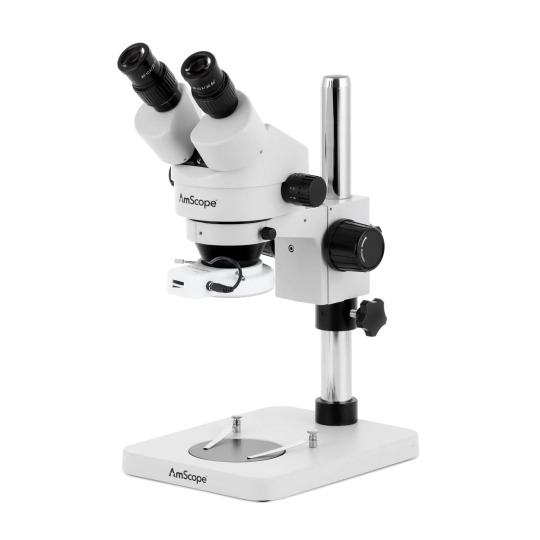
I'm a binocular/stereo microscope! I'm what you use to scout out your 'picks'. I'm going to give you headache after headache when you hyper-fixate on 'picking' microfossils...

After you've smashed up your rock, and boiled it, effectively 'disaggregating' (pulling the rock apart, like, a lot) with dish soap and some other chemical I can't remember, you're left with something similar to this. Oh, and you have to dry it out first, like, under heat lamps.
Then, spread a bit of the fossil/rock remnant mix onto a tray, like below (though, we had round ones that for the life of my I cannot find a picture of on the net #lesigh),

and using a super-fine paintbrush, (and sometimes we'd also use wooden dowels that had small metal poles with a rounded tip put into them - DIY Kiwi-style, yo...) sort through your mix.
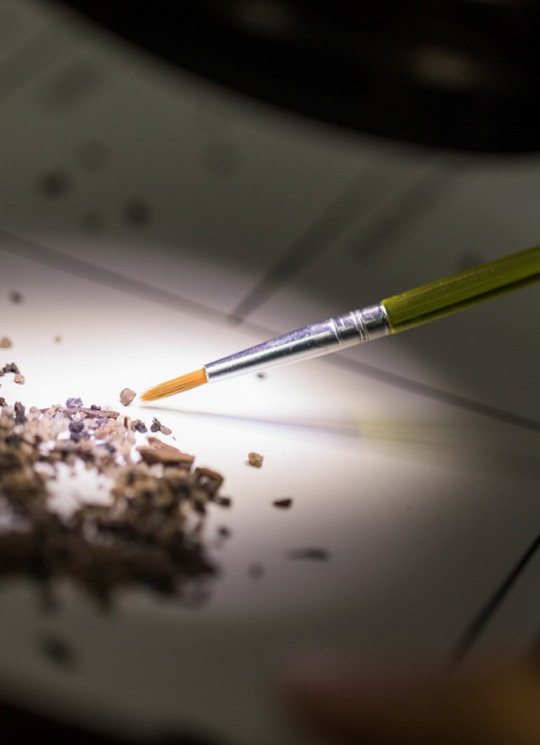
Once you've found/isolated a likely specimen that isn't just a piece of fancy sand, or shell piece, or fish bone (though you can add these to your tray if you want), and you've remembered to moisten the paintbrush tip, either with water or handy-dandy saliva from your very own mouth (you would not believe how much time this saves, though no sharing paintbrushes in these disease-ridden times), you can use said moistened brush to pick up your target and add it to your super-special micro-fossil slide!
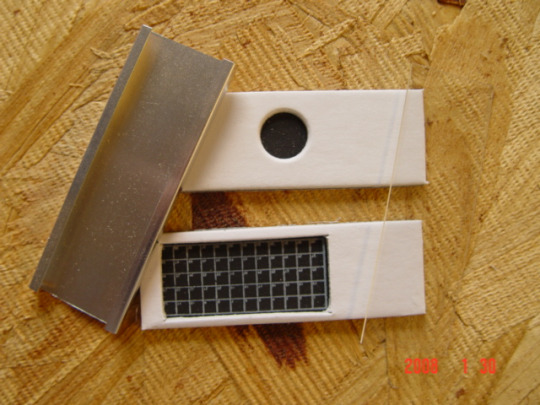
Above is an unused tray that has been pulled apart (ignore the slide with the circle, the grid one is where we are at). To put it back together once you're done 'picking', the glass slide goes overtop the cardboard 'grid' slide, and then they both slide into the metal tray. One would generally place groups of similar 'tests' (or shells) in the same grid number to identify later (or at the same time if you had mad skills).

We'd sometimes use a bit of green dye (and no, we didn't put the green dye in our mouths first...) to stain the tiny shells to help make identification easier.

Of course you ask what is the actual point of all this, other than a delightful, sometimes headache-inducing, way to pass a few hours in an activity that should be rather boring? Well. I'm going to tap into my memory and hope like hell that I recall this shite correctly. The main reason is being able to use these wee buggers to link a layer (or layers) of rock in different areas, because if you've got a couple of microfossils in one area, and the same types in another area, you can be all 'check-out-the-correlating-rocks-yo'. Or something. This is called biostratigraphy. It's especially useful if one rock layer is near a datable-by-isotype-type-rock like lava rocks, because then you can extrapolate that shite everywhere, and voila! Dateable rocks! And organised rocks!
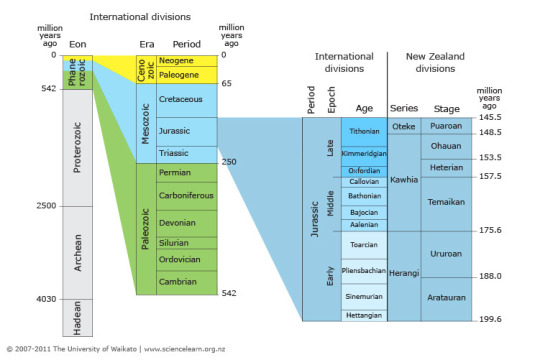
Species change though time because of that pesky evolution thing, or completely unsubscribe from life, and can be linked to age ranges (like an upper and a lower limit from when they are first found and when they are last found in a rock) in the geological time scale. Of course, the geological timescale lives to confuse, and add in localised time periods that link to localised rock formation names (I'll explain later #lesighpartdeux) that somehow tie into the epochs and eras and before long:

BUT THAT'S NOT ALL! Micro-palaeontology (or micro-pal, for those of us cool geology kids) is used extensively in the oil/gas exploration industry, for better or worse, well, worse really, but yeah, via the whole biostratigraphy schtick (they drill a core (like, a long shaft of rock) and then figure out the rock types and use microfossils to date and correlate, and then use it when they are already in an oil 'field' to check where the right rocks are, because it's not normally flat layers of rocks awaiting exploitation. It's more like a jumbled up jigsaw puzzle with some parts of the same rock up, some down, some folded/squashed together, some starting to get a little baked, and some eroded away long before the rest of the rocks were buried. Fun stuff all around!):

(I spent far too long in Publisher making this stupid representative graphic and I can already see things I've missed out *LABELS ANYONE???* but oh well...) but also there's this thing called palaeoecology AND also also palaeoclimatology that are super useful for establishing past climates and environments, which I'll go into later because this is getting stupid long and my brain is fried and needs sleep but I've got one last thing that I want to mention that may be one of the greatest things ever about geology and palaeontology and micro-pal and so on and so forth.
!!!!!OTOLITHS!!!!

WHAT ARE OTOLITHS, I HEAR YOU ASK?????
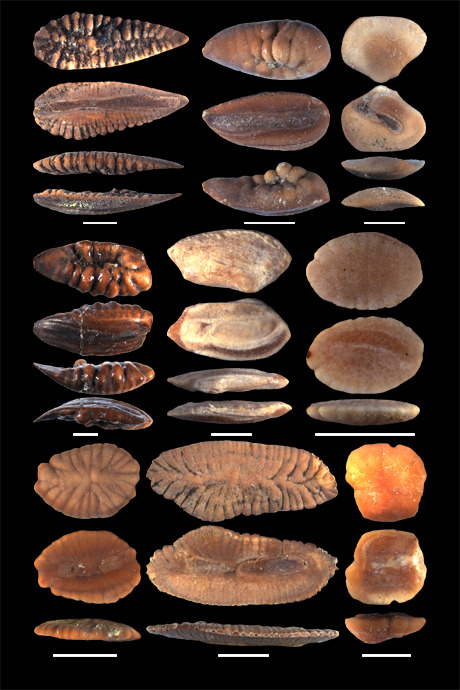
Fossilised fish ears! Who would have thought? I didn't even really think fish could hear underwater, which I believe such dimness is called BEING A MUPPET in my culture...
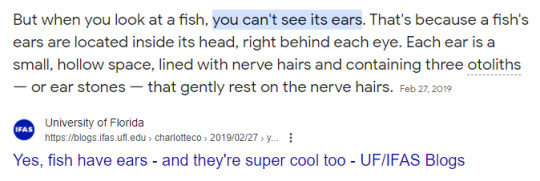
But it's true! I remember being so so so so so confused when I was picking forams for some geology lab and there were these funny shaped things in my rock mix. And they have such a variety of shapes.
And that's all for now, must sleep, will prolly revise this since it's prolly a load of crap geoscicomm but I'll get there! Happy micro-paling!

when i die i hope i come back as a beautiful microscopic granule of sand
#microfossils#micropalaeontology#palaeontolgy#binocs#foraminifera#forams#geoscicomm#geology#picking#super special micropal slides#Oh I forgot pollen#maybe next time#ooo do you know what a phytolith is?#if I've spelt it correctly lol#FISH HAVE EARS#terrible graphics#palaeoecology#palaeoclimatology#not that there's much about them#also next time#It's over!!!!
76K notes
·
View notes
Text

NEW IN OUR STORE - Planulina T-shirt! Available in dark and white print, with a big bold look that is sure to be a great head turner and conversation starter. ;)
Print-on-demand is a great way to combat overproduction and fast fashion. Our designs will be perpetually available, and T-shirts will only be printed once you place an order. Our print-on-demand company choices were also made considering that they work and fulfil from all around the world, choosing the closest factory to you to print and fulfil your order. This way they are taking the shortest route possible to reach you.
Right now you can choose between buying this shirt in our Etsy store or Teepublic. They offer different T-shirt colours, but also fulfill from different parts of the world so you can choose one which has a preferable shipping option to your region.
As we expand to other print-on-demand platforms, we'll be choosing those that offer ethical brands, and renewable energy to power their printing and fulfilment centres and are (working on) replacing their packaging with plastic-free and recycled materials. This way we believe Palaeoiris can share love and art with everyone in a sustainable way. "
#Foraminifera#Microfossils#Forams#PaleontologyFashion#ScienceTee#PaleoApparel#GeologyFashion#FossilFashion#ScienceWear#MicrofossilArt#ForaminiferaDesign#PaleontologyClothing#MicroscopicLife#Foraminiferan#PrehistoricFashion#Micropalaeontology#MicropalaeontologyTee#MicropaleontologyTee#MicropalaleontologyTshirt#Micropalaleontologyfashion#Micropaleontologyfashion#Micropalenotologygift#PlanulinaTshirt#PlanulinaArt#Planulina#Foramgift#Foraminiferagifts#foram gifts#foraminifera gifts#gifts for scientists
0 notes
Text
abiogenesis & endosymbiosis timeline
I put this together after reading Nick Lane's The Vital Question. The proposed timeline:
3.8bya: The earliest evidence for life is isotopic fractionation. The carbon (and iron, sulfur, nitrogen) atoms in graphite in Greenland are non-randomly sorted, which indicates the presence of cells whose enzymes have a slight preference for the lighter forms of each. However, geological processes can also produce non-random sorting, so this evidence is ambiguous.
3.5bya: Less ambiguously, we have microfossils that look like cells, again with isotopic signatures.
We think bacteria and archaea split off really early, close to the beginning of life (abiogenesis) itself. This is because their cell walls and membranes are so different it's hard to see how one could have evolved from the other. They probably emerged in parallel when they became independent at all. (Quick sketch of abiogenesis, and bacteria/archaea divergences.)
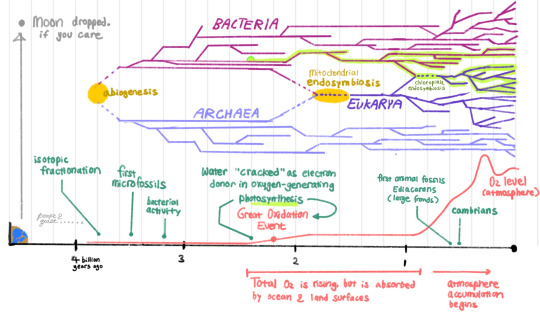
3.2bya: We see bacterial activity in rust bands in rocks. When bacteria strip electrons from iron dissolved in the oceans, the oxidated iron precipitates out into rust and sinks down to the ocean floor.
All bacteria and archaea respire (strip electrons from a donor 'fuel' to generate ATP, which fuels cellular activity). Many donors are possible – common ones are Fe2+, H2S, or H2O (which respectively become Fe3+, S, and O2 after the electron is stripped). Water is the last to be cracked as a donor.
2.4bya: It's cracked now, by some bacteria (archaea never manage it), which leads to The Great Oxidation Event. The oxygen is first absorbed by the oceans, the seabed, and land surfaces. It'll take over a billion years before the oxygen 'sinks' are exhausted, and oxygen accumulates in the atmosphere for real.
1.8bya: A bacterium somehow ends up inside an archaeon cell, and somehow they don't die about it. The bacterium becomes a specialized energy-producing unit, allowing the host cell to grow larger and more complex. They become the first eukaryote, invent sex, and spawn all complex life. (You can read my RPF about it btw.)
1bya: This engulfment – endosymbiosis – happens one more time, to produce chloroplasts in plants.
0.5-6bya: Atmospheric oxygen levels are rising for real now. We see large complex eukaryotes for the first time. These creatures have specialized tissues whose failure threatens the entire organism, and it becomes advantageous to separate out the germline (the part of eukaryotes that divide forever, e.g. sperm and eggs) and make the rest of the body just durable enough to last as long as the most failure-prone tissues. Death by design has entered the world.
212 notes
·
View notes
Text




I finished more of these absolute miniscule curio collection pendants! I try to fit as many tiny interesting items into each of these pendants as I possibly can. Some of the possible contents:
Snake bones
Rodent bones
Emu eggshell pieces
Sea shells
Sea urchin spines or pieces of urchin test
Ancient Egyptian beads
Preserved sea weed
Jewel beetle shell pieces
Microfossils
Japanese star sand
Barnacle feeding limb shells
Horseshoe crab claw
Cicada wing or shell limb
Shark tooth fossil
Bryozoan fossil
Various rocks/crystals (opal, Garnet, grape agate, chalcopyrite, etc.
And more!
Link in bio if you want one, or message me if you want a different one. Each comes with a list of the contents!
#goblincore#oddities#vulture culture#miniature#tiny things#crowcore#cabinet of curiosities#natural history#curio collection#curio#resin jewelry#resin art#witchy jewelry#witchy things#my art#potion bottles
73 notes
·
View notes
Text

A Meteorite From Mars - August 17th, 1996.
"The famous Martian meteorite pictured above houses microscopic structures, interpreted by many as fossils of ancient Martian life. How do you find a meteorite from Mars here on Earth? On a typical day, several large rocks fall to Earth from space, usually winding up in the oceans. If they do not burn up in the Earth's atmosphere, they are called meteorites. Most meteorites falling on land are never located or identified - appearing similar to other rocks to the untrained eye. In certain places in Antarctica, however, meteorites stand out from the white frozen ice and snow beneath them, as if they were just left yesterday. When the above meteorite was found in Antarctica, it was considered unusual because of its grey colour. At the time, about 12 Martian meteorites��of similar mineral compostion had been found. One of these contained minute pockets of gases, identical in isotopic composition to the Martian atmosphere as determined from the Viking measurements - implying the rocks indeed originated on Mars. These Martian meteorites are typically 1.3 billion years old or less, however, the one containing the potential microfossils appears to have an age of about 4.5 billion years."
45 notes
·
View notes
Text
Fossil Microbial Mats

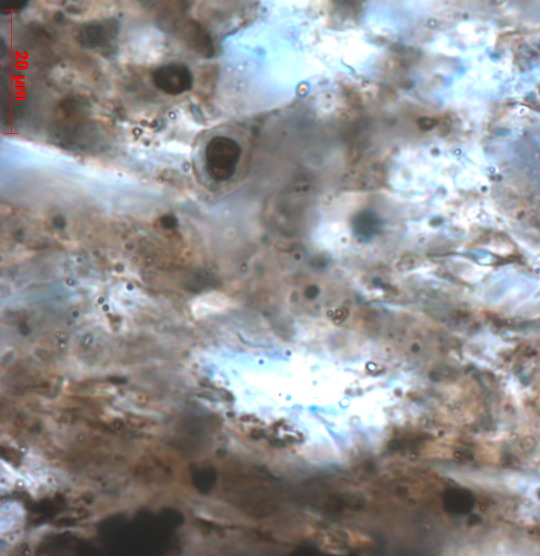
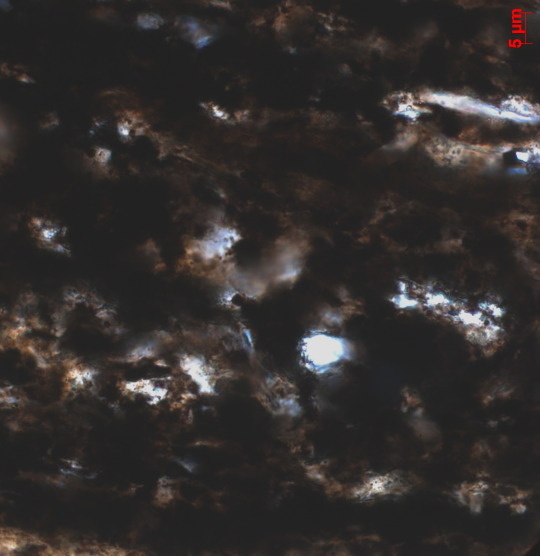
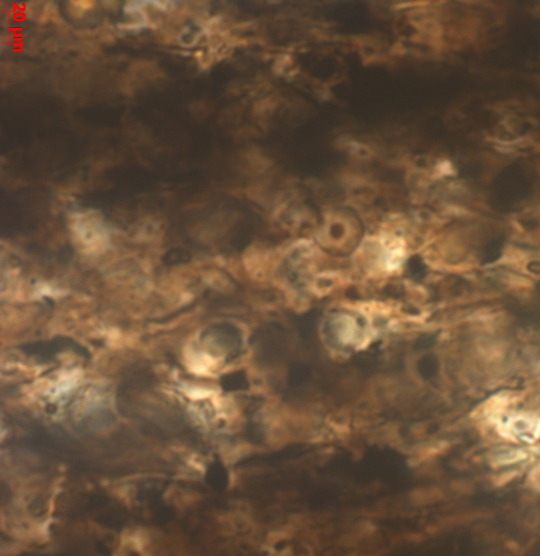
Extreme close ups of 1.3 billion year old microbial mats in muddy OM rich chert. Fossils are the dark filaments and spheres, surrounded by a pale coating of phosphate and silica. Some fossils have been replaced by silica, phosphate, or pyrite. The little spheres and long filamentous structures are the fossil microbes. The scale bar at the side says 20 microns, which is a bit thinner than a human hair. So that gives you an idea of how tiny these microbes where.
Each sphere and filament was a tiny colony of individual microbes. So each sphere and filament is like a tower block full of apartments the microbes lived in, and the mat is like a city.
But these mats were so dense and thick, that if you scaled up one of the fossil microbes to the size of an average human, the mat would be 25 km high and cover all of Europe and most of Asia.
Mats like this covered the floor of Earths shallow seas long before animals and plants evolved. The tops of the mats were photo synthesisers, below them live microbes that could convert sulphur and iron into energy.
These microbial communities worked nonstop for billions of years, changing the chemistry of the Earths oceans and atmosphere, pumping out oxygen, and making the world habitable to more complex life like the first simple animals, and eventually humans.
They were here long before even the simplest animals and plants, and they will be here long after we have gone. Microbial mats like this will probably be some of the last life on Earth, and I wouldn't be surprised if they were common on warm, wet, rocky planets throughout the universe.
#Paleontology#Geology#geologyjohnson#palaeontology#precambrian#fossils#fossil#fossilfriday#acritarch#microbes#Bacteria#Microfossil#thinsectionthursday
23 notes
·
View notes
Text

Microfossil Exhumation
2024, carved acrylic paint on wood panel, 12x12 inches
Carved Heterostegina test or shell. Looking at different ways carving and excavating connected to fossils can be explored in my art practice. Painting hasn’t been scratching my brain itch as much lately but carving into paint seems like a game changer. I love forams!
#my art#painting#art#queer artist#acrylic painting#carving#paint carving#relief#sculpture#foraminifera#forams#fossil#marine biology#paleoart
88 notes
·
View notes
Text
The oldest evidence of photosynthetic structures reported to date has been identified inside a collection of 1.75-billion-year-old microfossils, a Nature paper reveals. The discovery helps to shed light on the evolution of oxygenic photosynthesis. Oxygenic photosynthesis, in which sunlight catalyzes the conversion of water and carbon dioxide into glucose and oxygen, is unique to cyanobacteria and related organelles within eukaryotes. Cyanobacteria had an important role in the evolution of early life and were active during the Great Oxidation Event around 2.4 billion years ago, but the timings of the origins of oxygenic photosynthesis are debated due to limited evidence.
Continue Reading.
143 notes
·
View notes
Text
The Science of Discovering the Past: Paleoethnobotany

Source: https://pixahive.com/photo/different-types-of-green-plants-grown-in-front-garden/
Plants have been important to hominids from the very first of our line. Understanding that connection is the milieu of paleoethnobotany or archaeobotany. Paleoethnobotany is the preferred term in North America, acknowledging the the 'contribution that ethnographic studies have made towards our current understanding of ancient plant exploitation practices' and archaeobotany is preferred in Europe as it 'emphasizes the discipline's role within archaeology'.

By Cmhenkel - Own work, CC BY-SA 4.0, https://commons.wikimedia.org/w/index.php?curid=104404554
As a field, paleoethnobotany is about 200 years old. In the early 19th century, the chance discovery of desiccated or waterlogged materials were the first macrofossiles that were researched by botanist C. Knuth in 1826 in Egypt and O Heer in Switzerland (respectively). Interest in plants in the North America didn't pick up until the 1930s when M.R. Gilmore and V.H. Jones studied dessicated remains in the American Southwest. These studies focused cataloging and simple identification of plants found in archaeological sites.
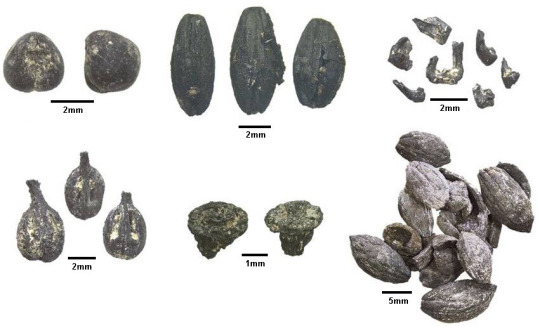
By Cmhenkel - Own work, CC BY-SA 4.0, https://commons.wikimedia.org/w/index.php?curid=104397525
During the 1950s and 1960s, researchers pushed for paleoethnobotany to be recognized as a subfield of archaeology. There were two main catalysts for this effort, the recovery of plant materials in the Near East and the publication of the report of excavations of Star Carr, a Mesolithic site about 8km from Scarborough in North Yorkshire. Together, these convinced the archaeological community that studying plant remains were important to the discipline.

By Cmhenkel - Own work, CC BY-SA 4.0, https://commons.wikimedia.org/w/index.php?curid=104394010
In the 1970s, the idea that archaeology was also anthropology, or Processul archaeology, caused a rise in the field of paleoethnobotany. New recovery methods, such as the flotation method, where water is used to separate the carbonized plant remains from sediment and a sieve is used to recover the fossilized plant remains. In the 1990s, Post-Processual archaeology or interpretative archaeology broadened the field to include topics such as 'food-related gender roles'.

By Cmhenkel - Own work, CC BY-SA 4.0, https://commons.wikimedia.org/w/index.php?curid=104396223
More recently, techniques have improved in collecting and analyzing remains as well as the ability to find microfossils, allowing researcher to develop a fuller picture of how early hominids used plants. This also allows researchers to understand how intense agricultural labor was, how resilient settlements and hunter-gatherer groups were, and how these changed and influenced with long-term social and economic changes.
8 notes
·
View notes
Note
Hi, saw your tag about fossilized pollen not being microscopic and I. I don't think I've ever heard of ancient pollen grains being anything but microfossils. Could you elaborate? Thanks!!
God I wish I Could elaborate but I cannot for the life of me remember what it was called I would have to like email my sedimentation professor from college but in my paleontology class in college we looked at some of his pollen samples because he was specifically a paleobotanist and a lot you could just like see with the naked eye rattling around in the little containers he had them in some of them were fun and star shaped the most we used on any of them were like our hand lenses
I guess this is also how you categorize a microfossils they were all of course very very small because of course they were but what I was saying is that you didn't need a microscope to see them so maybe that's where some of this confusion is
Hell you can see some extant pollen with the naked eye too back home where im from in Georgia there were times of the year where pollen would sometimes rain down like snow and I would watch it accumulate on my phone screen and could definitely make out the individual bits
#of course there are definitely still also the ones that just blend right into the matrix of the soil samples you pulled them from#but i think a lot of the super old ones are actually kinda bigger#but im talking like Mesozoic stuff I Think once again take this with a grain of salt because i havent been in college since uh#like 2018 and i havent been in my paleo class specifically since a year or two before then#AND i was kind of bored out of my nind during our small paleo segment because ita not really my thing#was trying to google to find the ones i was looking for but unfortunately no luck cause i have no idea what the plant name was ugh#this is what happens when you get a degree in geology and then dont use it for 7 years#i went to look up his papers about his pollen research but dont have access to any of the articles cause of paywalls hhhhh#whats particularly frustrating about this is that i Know that i have a picture of them i Know that i do#but i also know that those pictures are stored in some stupid folder titled phone on my old laptop which as of right now doesnt seem to want#to turn on anymore which is a huge bummer on multiple fronts#ugh
4 notes
·
View notes
Text


Print-on-demand is a great way to combat overproduction and fast fashion. Our designs will be perpetually available, and T-shirts will only be printed once you place an order. Our print-on-demand company choices were also made considering that they work and fulfil from all around the world, choosing the closest factory to you to print and fulfil your order. This way they are taking the shortest route possible to reach you.
Right now you can choose between buying this shirt in our Etsy store or Teepublic. They offer different T-shirt colours, but also fulfill from different parts of the world so you can choose one which has a preferable shipping option to your region.
As we expand to other print-on-demand platforms, we'll be choosing those that offer ethical brands, and renewable energy to power their printing and fulfilment centres and are (working on) replacing their packaging with plastic-free and recycled materials.
This way we believe Palaeoiris can share love and art with everyone in a sustainable way.
palaeoiris.etsy.com, teepublic.com/user/palaeoiris.
#palaeoiris.etsy.com#teepublic.com/user/palaeoiris.#Foraminifera#Microfossils#Forams#PaleontologyFashion#ScienceTee#PaleoApparel#GeologyFashion#FossilFashion#ScienceWear#MicrofossilArt#ForaminiferaDesign#PaleontologyClothing#MicroscopicLife#Foraminiferan#PrehistoricFashion#Micropalaeontology#MicropalaeontologyTee#MicropaleontologyTee#MicropalaleontologyTshirt#Micropalaleontologyfashion#Micropaleontologyfashion#Micropalenotologygift#PeneroplisTshirt#PeneroplisArt#Peneroplis#Foraminiferagift#Foramgifts
0 notes